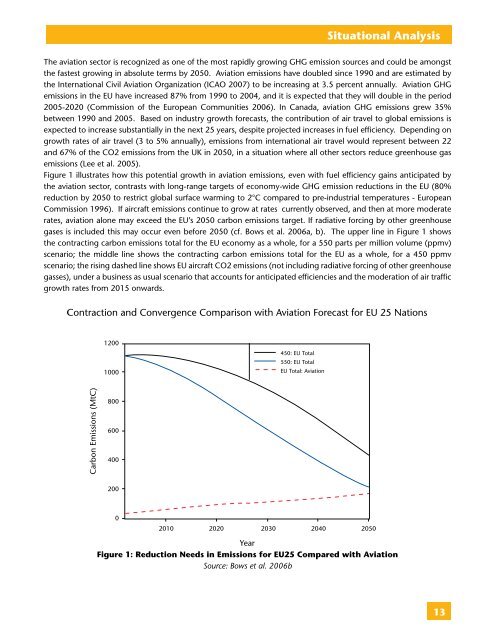Tourism & CC Challenges & Opportunities - Global Commons Institute
Tourism & CC Challenges & Opportunities - Global Commons Institute
Tourism & CC Challenges & Opportunities - Global Commons Institute
Create successful ePaper yourself
Turn your PDF publications into a flip-book with our unique Google optimized e-Paper software.
Situational Analysis<br />
The aviation sector is recognized as one of the most rapidly growing GHG emission sources and could be amongst<br />
the fastest growing in absolute terms by 2050. Aviation emissions have doubled since 1990 and are estimated by<br />
the International Civil Aviation Organization (ICAO 2007) to be increasing at 3.5 percent annually. Aviation GHG<br />
emissions in the EU have increased 87% from 1990 to 2004, and it is expected that they will double in the period<br />
2005-2020 (Commission of the European Communities 2006). In Canada, aviation GHG emissions grew 35%<br />
between 1990 and 2005. Based on industry growth forecasts, the contribution of air travel to global emissions is<br />
expected to increase substantially in the next 25 years, despite projected increases in fuel efficiency. Depending on<br />
growth rates of air travel (3 to 5% annually), emissions from international air travel would represent between 22<br />
and 67% of the CO2 emissions from the UK in 2050, in a situation where all other sectors reduce greenhouse gas<br />
emissions (Lee et al. 2005).<br />
Figure 1 illustrates how this potential growth in aviation emissions, even with fuel efficiency gains anticipated by<br />
the aviation sector, contrasts with long-range targets of economy-wide GHG emission reductions in the EU (80%<br />
reduction by 2050 to restrict global surface warming to 2°C compared to pre-industrial temperatures - European<br />
Commission 1996). If aircraft emissions continue to grow at rates currently observed, and then at more moderate<br />
rates, aviation alone may exceed the EU’s 2050 carbon emissions target. If radiative forcing by other greenhouse<br />
gases is included this may occur even before 2050 (cf. Bows et al. 2006a, b). The upper line in Figure 1 shows<br />
the contracting carbon emissions total for the EU economy as a whole, for a 550 parts per million volume (ppmv)<br />
scenario; the middle line shows the contracting carbon emissions total for the EU as a whole, for a 450 ppmv<br />
scenario; the rising dashed line shows EU aircraft CO2 emissions (not including radiative forcing of other greenhouse<br />
gasses), under a business as usual scenario that accounts for anticipated efficiencies and the moderation of air traffic<br />
growth rates from 2015 onwards.<br />
Figure 1: Reduction Needs in Emissions for EU25 Compared with Aviation<br />
Source: Bows et al. 2006b<br />
13
















